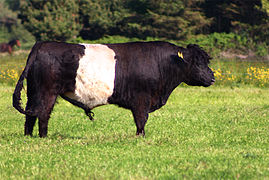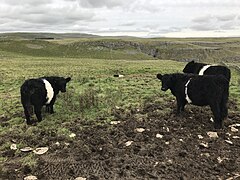Belted Galloway
 At pasture | |
| Conservation status | |
|---|---|
| Other names |
|
| Country of origin | Scotland |
| Distribution | world-wide |
| Use |
|
| Traits | |
| Weight | |
| Coat | black with broad white stripe around middle |
| Horn status | polled |
The Belted Galloway is a traditional Scottish breed of beef cattle. It derives from the Galloway cattle of the Galloway region of south-western Scotland, and was established as a separate breed in 1921. It is adapted to living on the poor upland pastures and windswept moorlands of the region. The exact origin of the breed is unclear, although the white belt for which they are named – and which distinguishes the breed from the native black Galloway cattle – is often surmised to be the result of cross-breeding with the similarly-coloured Dutch Lakenvelder breed.
Belted Galloways are primarily raised for their quality marbled beef, although they are sometimes milked or kept for ornament.
History[]
The Belted Galloway derives from the traditional Galloway cattle of the Galloway region of south-western Scotland, which in turn form part of a broader group of traditional Scottish cattle including the Aberdeen Angus and Highland breeds.[4]: 129 Galloways are most often black, but other colours occur; the white-belted or white-middled Galloway was one of them. The origin of the white belt is unknown; it is thought to have resulted from some cross-breeding with Dutch Lakenvelder cattle in the seventeenth century.[4]: 129
From 1852, both Aberdeen Angus and Galloways could be registered in a herd-book for polled cattle. A separate Galloway herd-book was established in 1878. In 1921 a group of breeders set up the Dun and Belted Galloway Association, which – as the name suggests – registered both belted and dun-coloured Galloways; its first herd-book was published in 1922. In 1951 registration of dun cattle was discontinued, and the society changed its name to the Belted Galloway Society.[4]: 129
In the twentieth century, Belted Galloways were exported to many countries including Australia, Brazil, Canada, France, Germany, Holland, New Zealand and the United States. Breed societies were started in New Zealand in 1948, in the US in 1951, and in Australia in 1975.[4]: 129
Like other breeds, the Belted Galloway suffered heavily during the epidemic of foot-and-mouth disease in the British Isles in 2001, and a substantial part of the total population was lost. By 2007 numbers had recovered to the point where it could be removed from the endangered native breed watchlist of the Rare Breeds Survival Trust;[4]: 129 in the same year the global breed population was listed by the FAO as "not at risk".[1]: 143 In 2012 there were approximately 3500 registered breeding cows in the United Kingdom.[4]: 129
It is listed by the American Livestock Breeds Conservancy as a "recovering" breed, [5] which means there are more than 2,500 annual registrations in the United States and a global population greater than 10,000, but they were once on the "watch" list.[6] About 18,390 cattle were registered in the US in 2015.[7]
Characteristics[]

Galloway cattle are naturally polled (without horns). The most visible characteristics are its long hair coat and the broad white belt that completely encircles its body. Its coarse outer coat helps shed the rain, and its soft undercoat provides insulation and waterproofing, enabling the breed to spend winter outside.[8] Black Belteds are the most prominent, but Dun and Red Belteds are also recognised by breed societies, the latter being comparatively rare and sought after. A female Belted Galloway cannot be registered in the Herd Book if it has white above the dewclaw other than the belt, but can be registered in the Appendix. A bull can only be registered in the Herd Book if it has no other white than the belt.[9]
The dun colour is caused by a mutation in the PMEL gene, the same mutation that causes dun and silver dun in Highland cattle.[10] The black and red coat colours are caused by the same alleles of the MC1R gene, ED for black and e/e for red, as in most other breeds of cattle.
Bulls weigh from 1,700 to 2,300 pounds (770 to 1,040 kg), with the average being around 1,800 pounds (820 kg). Cows weigh from 1,000 to 1,500 pounds (450 to 680 kg), with the average being around 1,250 pounds (570 kg). Calves generally weigh around 70 pounds (32 kg) at birth.[citation needed] Belted Galloways are generally of a quiet temperament, but still maintain a maternal instinct and protect calves against perceived threats.[8][11]
They are well-suited for rough grazing land and will use coarse grasses other breeds would shun. They are able to maintain a good condition on less than ideal pasture, and produce high-quality beef on grass alone.[citation needed] They have on occasions attacked people.[12]
Use[]
The Belted Galloway is reared mainly for beef; it may also be used for vegetation management.[13] An old strain is listed as the "Original Belted Galloway Cattle" in the Ark of Taste of the Slow Food Foundation for Biodiversity.[14]
Gallery[]

Belted Galloway bull in Denmark
Belted Galloway in Nordfriesland
Beltie calf in Nordfriesland

Belted Galloways in the Yorkshire Dales

A young belted galloway in Gloucestershire , UK.
References[]
| Wikimedia Commons has media related to Belted Galloway. |
- ^ a b Rischkowsky, Barbara and Pilling, D. (eds.) (2007). List of breeds documented in the Global Databank for Animal Genetic Resources, annex to The State of the World's Animal Genetic Resources for Food and Agriculture. Rome: Food and Agriculture Organization of the United Nations. ISBN 9789251057629. Accessed January 2017.
- ^ Cattle watchlist. Rare Breeds Survival Trust. Accessed May 2019.
- ^ Conservation Priority List. The Livestock Conservancy. Accessed May 2019.
- ^ a b c d e f g h Porter, Valerie; Alderson, Lawrence; Hall, Stephen J.G.; Sponenberg, Phillip (2016). Mason's World Encyclopedia of Livestock Breeds and Breeding (6th ed.). Wallingford: CABI. ISBN 9781780647944.
- ^ "Belted Galloway". American Livestock Conservancy. Retrieved 20 June 2015.
- ^ "Parameters for Classification". American Livestock Conservancy. Retrieved 25 August 2015.
- ^ "Newsletter" (PDF). Belted Galloway Society. April 2015. p. 4. Retrieved 25 August 2015.
- ^ a b "Belted Galloway". Rare Breeds Survival Trust. Archived from the original on 27 December 2016. Retrieved 20 June 2015.
- ^ "Registration Criteria". Belted Galloway Society. Retrieved 25 August 2015.
- ^ Schmutz, S. M.; Dreger, D. L. (2013). "Interaction of MC1R and SILV alleles on solid coat colors in Highland Cattle". Animal Genetics. 44 (1): 9–13. doi:10.1111/j.1365-2052.2012.02361.x. PMID 22524257.
- ^ "Belted Galloway". Britannic Rare Breeds. Archived from the original on 12 September 2011. Retrieved 20 June 2015.
- ^ "Woman trampled to death by cattle at Linchmere Common, inquest hears". BBC News. 20 September 2019. Retrieved 2 October 2020.
- ^ Felius, Marleen (1995). Cattle Breeds: An Encyclopedia. Doetinchem, Netherlands: Misset. ISBN 9789054390176.
- ^ Original Belted Galloway Cattle. Fondazione Slow Food. Accessed May 2019.
- Cattle breeds
- Conservation Priority Breeds of the Livestock Conservancy
- Cattle breeds originating in Scotland
- Dairy cattle breeds




